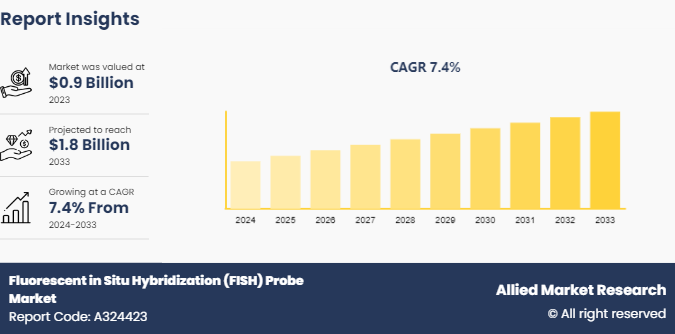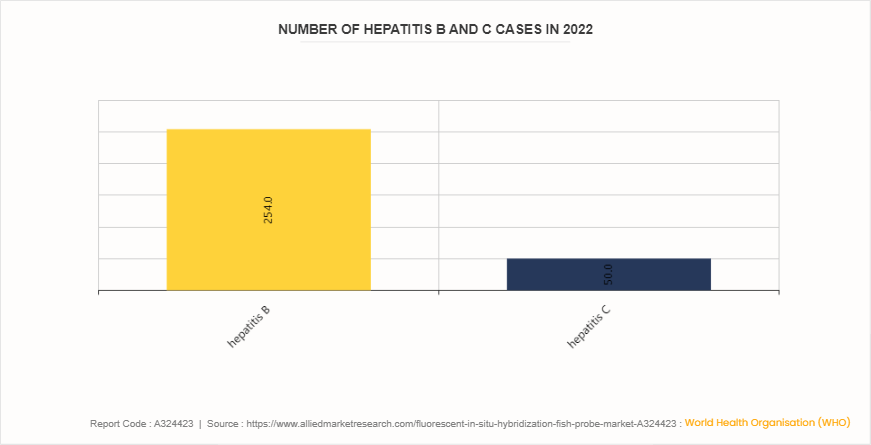Fluorescent In Situ Hybridization (FISH) Probe Market Research, 2033
The global fluorescent in situ hybridization (FISH) probe market size was valued at $0.9 billion in 2023, and is projected to reach $1.8 billion by 2033, growing at a CAGR of 7.4% from 2024 to 2033. The ability of FISH probes to provide accurate and specific genetic information enhances their application in personalized treatment plans, boosting market growth.

Market Introduction and Definition
A Fluorescent in Situ Hybridization (FISH) probe is a molecular tool used to detect and localize specific DNA or RNA sequences in cells or tissues. The FISH technique involves labeling a DNA or RNA probe with a fluorescent dye, which is then hybridized to a complementary target sequence within the sample. Upon binding, the probe emits a fluorescent signal that can be visualized under a fluorescence microscope, allowing for precise identification and localization of genetic material. This method is widely used in diagnostics, such as identifying chromosomal abnormalities, gene mapping, and detecting pathogens, due to its high sensitivity and specificity.
Key Takeaways
- The fluorescent in situ hybridization (FISH) probe market share study covers 20 countries. The research includes a segment analysis of each country in terms of value ($Billion) for the projected fluorescent in situ hybridization (FISH) probe market forecast 2024-2033.
- More than 1, 500 product literatures, industry releases, annual reports, and other such documents of major Fluorescent in Situ Hybridization (FISH) Probe industry participants along with authentic industry journals, trade associations' releases, and government websites have been reviewed for generating high-value industry insights.
- The study integrated high-quality data, professional opinions and analysis, and critical independent perspectives. The research approach is intended to provide a balanced view of global markets and to assist stakeholders in making educated decisions in order to achieve their most ambitious growth objectives.
Key Market Dynamics
The Fluorescent in Situ Hybridization (FISH) probe market growth is significant owing to several key drivers. The increasing focus on precision medicine and genomic research is a major driver for the FISH probe market. As personalized healthcare becomes more prevalent, the demand for precise diagnostic tools like FISH probes has surged. These probes allow for the detailed identification of genetic abnormalities, aiding in the diagnosis and treatment of various diseases, including cancer and genetic disorders.
Furthermore, the global rise in the incidence of cancer and genetic disorders is propelling the demand for advanced diagnostic techniques. FISH probes are extensively used in oncology to detect chromosomal abnormalities and gene mutations associated with different types of cancer. The growing awareness about early cancer detection and the benefits of targeted therapies has led to increased adoption of FISH probes in clinical settings. Additionally, the application of FISH in prenatal and postnatal genetic testing is expanding, driven by the need for early diagnosis and intervention in genetic disorders.
Despite the benefits, the high cost and technical complexity associated with FISH probe techniques pose a significant restraint to market growth. The process requires specialized equipment and skilled personnel to perform and interpret the results accurately. This can limit the adoption of FISH technology, particularly in low-resource settings and smaller diagnostic laboratories. Moreover, the time-consuming nature of the procedure may also hinder its widespread implementation.
Furthermore, ongoing technological advancements and the trend towards automation in diagnostic procedures present a significant opportunity for the FISH probe market. Innovations such as automated FISH systems and the development of more efficient and cost-effective probes are expected to streamline the workflow and reduce the overall cost of testing. This can enhance accessibility and adoption across various healthcare settings. Furthermore, integrating FISH with other advanced techniques, such as next-generation sequencing (NGS) , offers the potential for comprehensive genomic analysis, opening new avenues for market expansion.
Increase in number of Hepatitis B and C cases boosts the growth of the Fluorescent in Situ Hybridization (FISH) Probe Market
The rising prevalence of infectious diseases like Hepatitis B, Human Immunodeficiency Virus (HIV) , Herpes Simplex Virus (HSV) , and Chlamydia trachomatis is significantly driving the demand for Fluorescent in Situ Hybridization (FISH) probes. According to WHO data from 2022, approximately 254 million people live with Hepatitis B and 50 million with Hepatitis C. Notably, the majority of chronic infections are in individuals aged 30-54, with 12% in children under 18, and 58% of cases are among men. This high prevalence highlights the critical need for advanced diagnostic tools like FISH probes to accurately detect and manage these infections, thereby expanding their use in clinical settings.

Market Segmentation
The Fluorescent in Situ Hybridization (FISH) Probe industry is segmented into product type, application, end user, and region. On the basis of product type, the market is categorized into DNA Probe, and RNA Probe. On the basis of application, the market is categorized into cancer diagnosis, genetic disorders, infectious disease diagnosis, and others. On the basis of end user, the market is segmented into hospitals and diagnostic laboratories, research and academic institutes, and pharmaceutical and biotechnology companies. Region wise, it is analyzed across North America, Europe, Asia-Pacific, and LAMEA.
Regional/Country Market Outlook
The regional outlook for thefluorescent in situ hybridization (FISH) probe market share varies significantly across different areas. North America holds a substantial market share due to advanced healthcare infrastructure, high adoption rates, and strong research and development activities. Europe also shows robust growth, driven by increasing cancer diagnostics and genetic research. The Asia-Pacific region is emerging as a key market, with expanding healthcare access, rising research initiatives, and growing prevalence of genetic disorders. Latin America and the Middle East & Africa are witnessing gradual growth due to improving healthcare systems and rising awareness of advanced diagnostic techniques. Each region’s market dynamics are influenced by local healthcare needs and technological advancements.
- According to Center for Disease Control (CDC) , May 2024, each year, about 5, 700 babies born in the United States have Down syndrome. This means that Down syndrome occurs in about 1 in every 640 babies.
Industry Trends
- In April 2023, Myriad Genetics, Inc., a leader in genetic testing and precision medicine, and SimonMed Imaging, one of the largest independent outpatient medical imaging providers and physician radiology practices in the U.S. announced the planned launch of a new hereditary cancer assessment program that combines diagnostic imaging, genetic risk assessment utilizing MyRisk with RiskScore and patient education.
Competitive Landscape
The major players operating in the Fluorescent in Situ Hybridization (FISH) Probe market size include Thermo Fisher Scientific Inc., Perkinelmer Inc., BioDot, Horizon Diagnostics, Agilent Technologies, Inc., Abnova Corp., LGC Biosearch Technologies, Genemed Biotechnologies, Inc., Oxford Gene Technology IP Ltd., Biocare Medical, LLC, Qiagen (Exiqon A/S) , and GSP Research Institute, Inc.
Recent Key Strategies and Developments
- In July 2023, KromaTiD, a single-cell analysis life science tools company focused on the research, development and commercialization of products for the cell and gene therapy market, announced the launch of over 300 centromere, telomere and gene probes for use in directional Genomic Hybridization (dGH) in-Site assays.
Key Sources Referred
- World Health Organization (WHO)
- Centers for Medicare & Medicaid Services (CMS)
- National Health Service (NHS)
- ECIS - European Cancer Information System
- National Health Mission (NHM)
- Institute for Health Metrics and Evaluation
- Centers for Disease Control and Prevention (CDC)
- Food and Drug Administration (FDA)
- National Institutes of Health (NIH)
Key Benefits for Stakeholders
- This report provides a quantitative analysis of the market segments, current trends, estimations, and dynamics of the fluorescent in situ hybridization (FISH) probe market analysis from 2024 to 2033 to identify the prevailing fluorescent in situ hybridization (FISH) probe market opportunity.
- The market research is offered along with information related to key drivers, restraints, and opportunities.
- Porter's five forces analysis highlights the potency of buyers and suppliers to enable stakeholders make profit-oriented business decisions and strengthen their supplier-buyer network.
- In-depth analysis of the fluorescent in situ hybridization (FISH) probe market segmentation assists to determine the prevailing market opportunities.
- Major countries in each region are mapped according to their revenue contribution to the global market.
- Market player positioning facilitates benchmarking and provides a clear understanding of the present position of the market players.
- The report includes the analysis of the regional as well as global fluorescent in situ hybridization (FISH) probe market trends, key players, market segments, application areas, and market growth strategies.
Fluorescent in Situ Hybridization (FISH) Probe Market Report Highlights
| Aspects | Details |
| Market Size By 2033 | USD 1.8 Billion |
| Growth Rate | CAGR of 7.4% |
| Forecast period | 2024 - 2033 |
| Report Pages | 216 |
| By Product Type |
|
| By Application |
|
| By End User |
|
| By Region |
|
| Key Market Players | Thermo Fisher Scientific Inc., Horizon Diagnostics, Abnova Corp., Genemed Biotechnologies, Inc., Oxford Gene Technology IP Ltd., Biocare Medical, LLC, Perkinelmer Inc., QIAGEN (Exiqon A/S), Agilent Technologies, Inc., LGC Biosearch Technologies |
The total market value of fluorescent in situ hybridization (FISH) probe market was $0.9 billion in 2023.
The forecast period for fluorescent in situ hybridization (FISH) probe market is 2024 to 2033
The market value of fluorescent in situ hybridization (FISH) probe market is projected to reach $1.8 billion by 2033.
The base year is 2023 in fluorescent in situ hybridization (FISH) probe market .
A Fluorescent in Situ Hybridization (FISH) probe is a molecular tool used to detect and localize specific DNA or RNA sequences in cells or tissues. The FISH technique involves labeling a DNA or RNA probe with a fluorescent dye, which is then hybridized to a complementary target sequence within the sample.
Loading Table Of Content...



